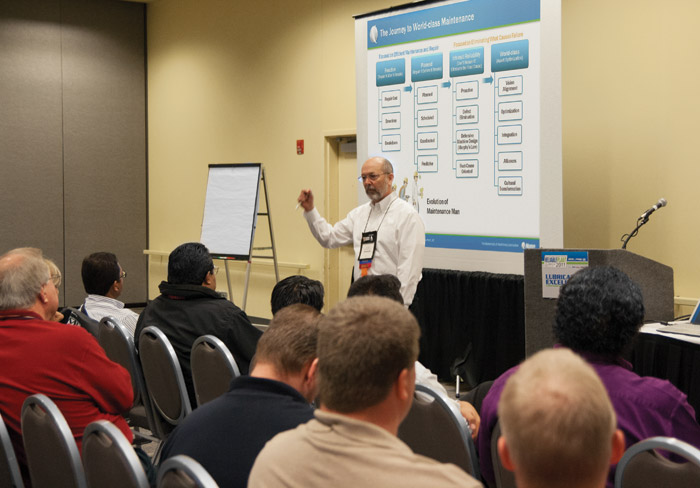Use Education and Training to Overcome Resistance to Change
What is the biggest hurdle when trying to implement a reliability or lubrication program? Is it funding or obtaining approval from upper management? Or maybe it’s that you have no idea where to even start?
Having designed and implemented world-class lubrication programs for many years, I know the answers to these questions. It has become easy for me to walk into a facility and compile a report of strengths, weaknesses, opportunities and threats. Within three days, I will have written more than 100 pages spelling out the current conditions, the optimum conditions and a gap analysis of how to bring the two more in line with one another. These exercises have become almost second nature to me. But why do some facilities that receive this information put it into practice, while others allow their programs to wither and die?

When I become part of a program, I like to share in its successes and failures, and I don’t like to fail. If there is a failure, I want to know why so I can prevent it from happening again. After a few investigations, I’ve come to the realization that almost all the failures (those that have not yet approached world-class status) had something in common - the stakeholders were not on the same page. They lacked a common goal and were pulling the program in different directions.
Upon further investigation, I found the root cause of the problem - people do not like change. There are many reasons for this apprehensiveness to change, including fear of the unknown, lack of trust, unconscious incompetence, ties to the old way of doing things and failure to communicate the project’s benefits. See the sidebar below for a more detailed list of the reasons why people resist change.
To combat this resistance, the first thing you should do is to expect it because it will happen. Of course, the pushback you receive can come in different levels of severity. It may feel like opposition is coming from the entire company at once or only from a select few individuals. However, if you are expecting it, it can be handled easily.
Now that you are anticipating resistance, plan how you will manage the objections. Take a proactive approach. Noria preaches proactive maintenance, but what about proactive objection management? A great way to start is to focus on the list of reasons for apprehensiveness to change. What can you do to ease this apprehension? Education and communication offer the best solution.
Before changes come flying down the organizational hierarchy, you must show those who will be most affected why the change is needed. The likelihood of success is severely diminished when the change comes in the form of an order. I’ve found that pushback and apprehension decrease to almost nothing if you take the time to sit down with those affected and educate them. Once they thoroughly understand the situation along with the nuances of the decision, they will either get onboard with the project or at least know enough about it to be able to make suggestions. Either of these situations is beneficial to the overall outcome of the project.
6 Reasons for Resistance to Change
Fear of the Unknown – People will only take steps toward the unknown if they believe that the risk of standing still is greater than that of moving in a new direction.
Competency – Change in an organization often necessitates a change in skills, and some people fear they won’t be able to make that transition.
Trust – If your organization has tried unsuccessfully to implement programs in the past, why should employees trust that this one will be successful?
Unconscious Incompetence – If there is no understanding of why a change is needed, the change rarely happens.
Ties to the Old Way – People are hard-wired and emotionally connected to a certain way of doing things. The longer they have been doing them that way, the harder it is to break that tie.
Failure to Communicate the Benefits – If you cannot easily help an individual or group see the benefits of change, they are much more likely to be resistant.
Frequently, I’ll spend a few hours on basic lubrication fundamentals and then begin discussions with the group about their particular plant. I like to use real-world examples and discuss opportunities that center around change. I also ask lots of leading questions to steer the conversation. When I hear, “Why haven’t we always been doing it like that?” I know I’ve won them over. Through education and communication, I have shown them that the new way is better and has less risk than the old way.
If you really want to increase the likelihood of success, put their new knowledge to use. Ask for input based on what they have learned from past experiences as well as their new awareness. When they start contributing, they will feel ownership in the cause. This is the ultimate goal. When others have contributed their ideas, time and effort to the decision for change, how can they oppose it?
Change management is the single most important aspect of implementing a lubrication or reliability program. You may have the best plan, equipment and backing and still fail if the people charged with making the change on the plant floor are not 100-percent onboard. Training and education are key to this onboarding process. With the amount of training available today, there is no longer a valid reason to be unconsciously incompetent. Make training a priority before the implementation of any program and you will see the likelihood of success skyrocket. Take the next step. Learn how Noria can help you implement a world-class lubrication program.
